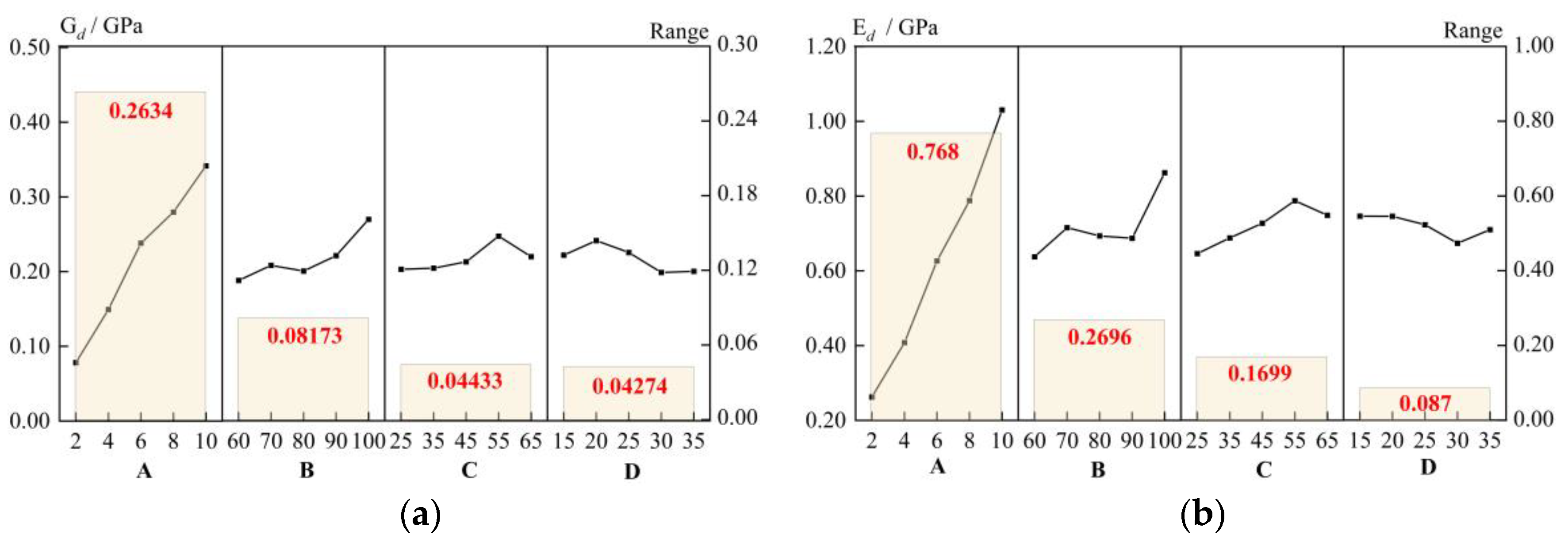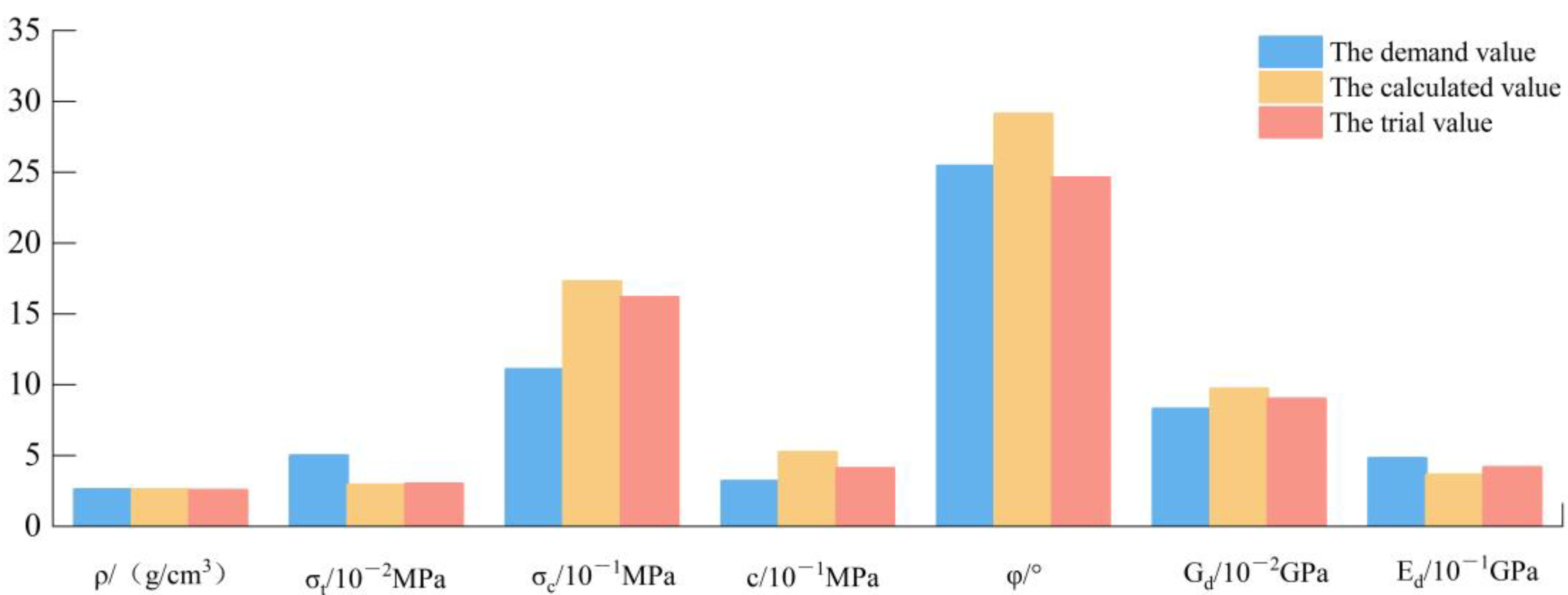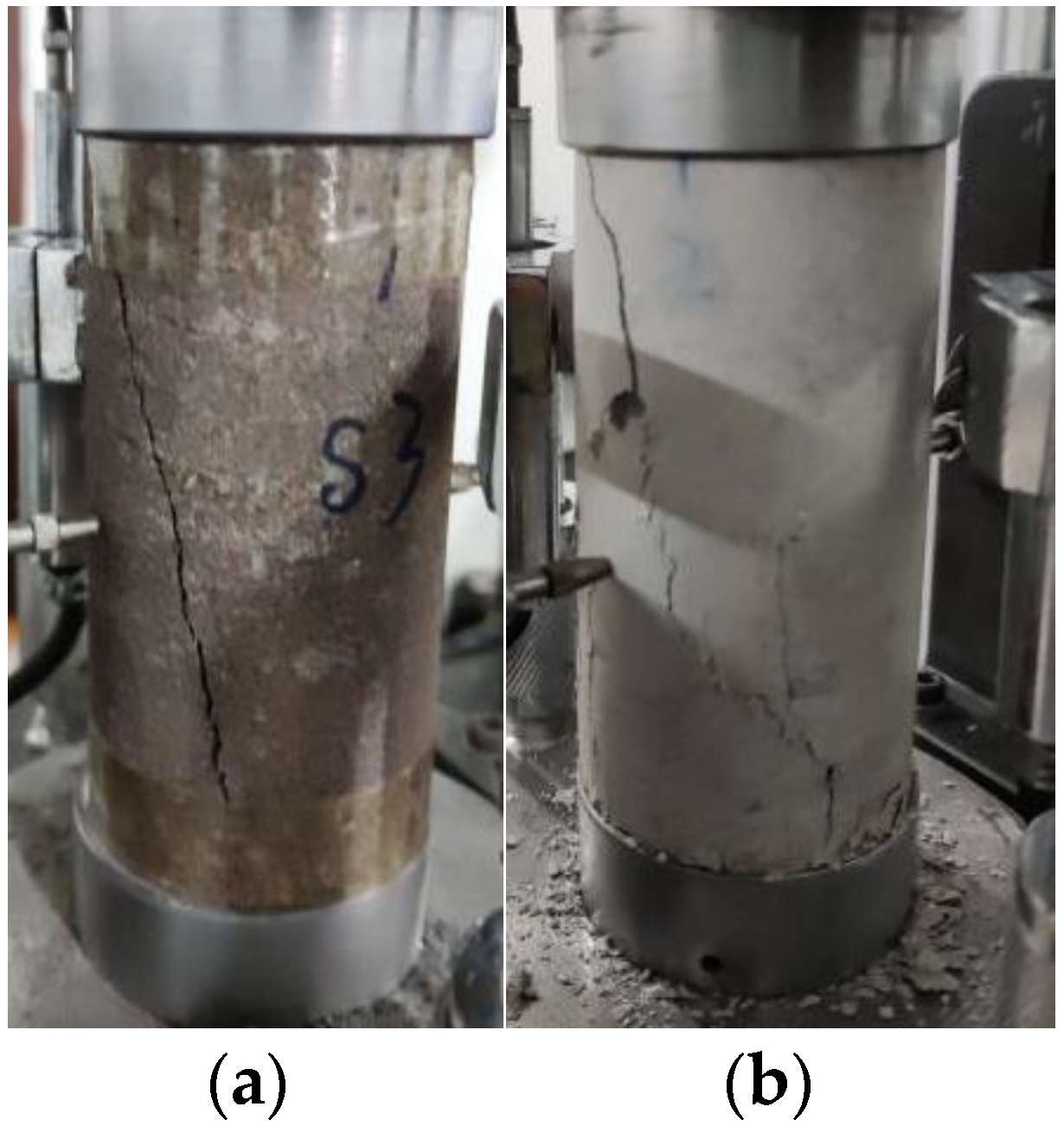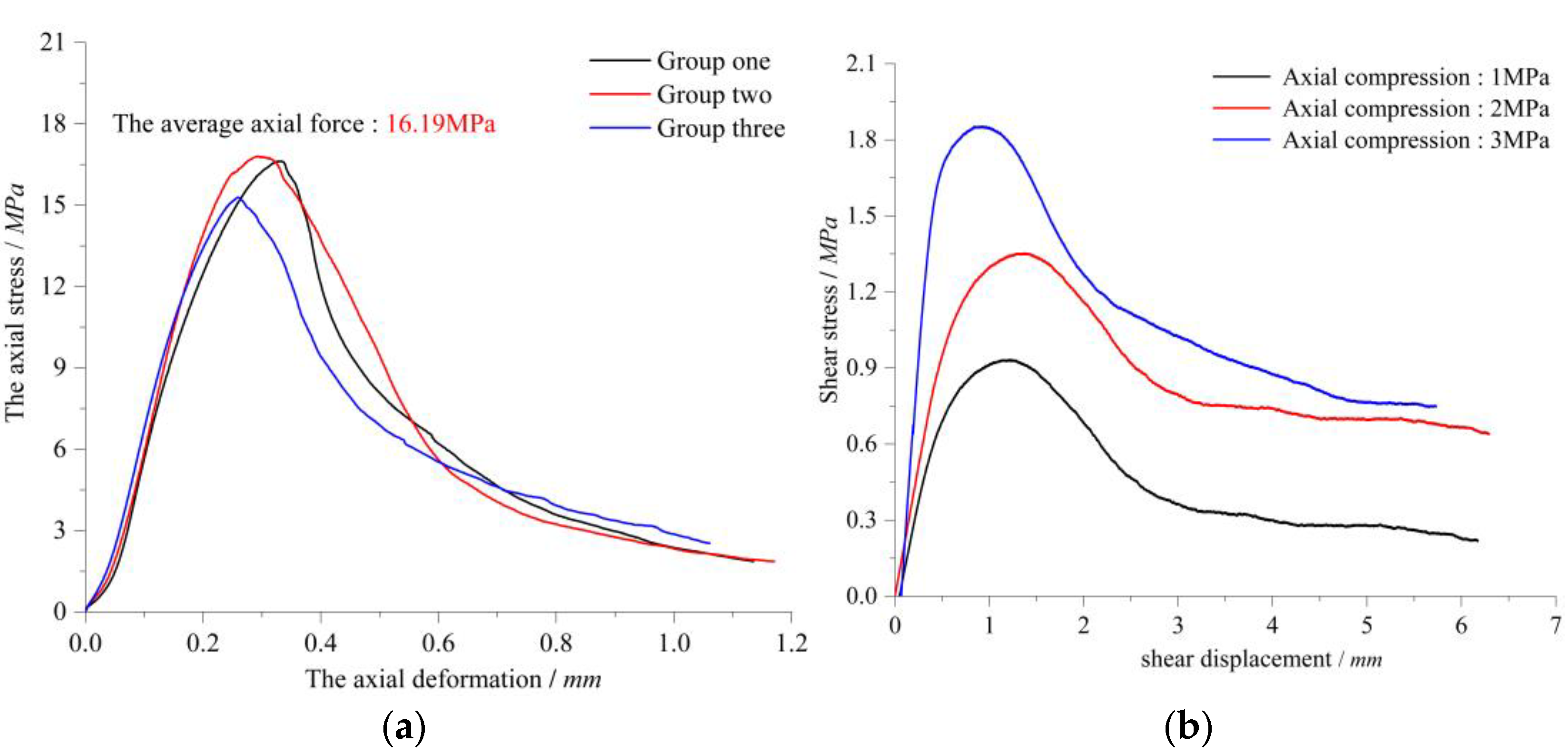Development of a Model Material for Dynamic Geotechnical Model Tests
Abstract
:1. Introduction
2. Selection of Similar Materials
2.1. Principle of Model Similarity
2.2. Determination of Physico-Mechanical Parameters
2.3. Selection of Model Materials Similar to Sandstone
3. Experimental Design
3.1. Design of the Orthogonal Test
3.2. Sample Preparation Process and Process
3.3. Physical and Mechanical Tests
4. Experimental Results and Sensitivity Analysis
4.1. Analysis of Test Results
4.2. Sensitivity Analysis
4.2.1. Sensitivity Analysis of Static Physico-Mechanical Parameters
4.2.2. Sensitivity Analysis of Dynamic Physico-Mechanical Parameters
5. Correlation Analysis between the Static and Dynamic Parameters and Proportions of Components in the Model Materials
5.1. Establishment of a Multiple Linear Regression Model
5.2. Multivariate Linear Fitting of Physico-Mechanical Parameters
- (1)
- Multivariate linear fitting of static parameters
- (2)
- Multivariate linear fitting of dynamic parameters
5.3. Significance Test of Multiple Linear Regression Equation
- (1)
- Hypothesis testing
- (2)
- Significance testing
6. Practical Application of the Proportions of Components in a Model Material Similar to an Actual Material
6.1. Engineering Geology Overview
6.2. Configuration of Similar Materials
6.3. Comparison and Verification of Raw Rock and Similar Materials
- (1)
- Physical parameter verification
- (2)
- Failure mode verification
- (3)
- Verification of failure process
7. Conclusions
- (1)
- Four factors, including cementing material/solid material, gypsum/cementing material, quartz sand/aggregate and ferric powder/(barite powder + ferric powder), were designed, and orthogonal tests were conducted with five levels for each factor. Seven parameters, including density, tensile strength, compressive strength, dynamic shear modulus, dynamic elastic modulus, cohesion and internal friction angle, were obtained by ultrasonic, uniaxial compression, direct shear and splitting tests. Among them, the dynamic shear modulus and dynamic elastic modulus most effectively reflected the changes in the dynamic parameters of rock.
- (2)
- Samples of model materials composed of gypsum, cement, quartz sand, ferric powder and barite powder met the similar material requirements for sandstone in a large range of model tests.
- (3)
- The analysis of the sensitivity of various factors showed that the density was mainly influenced by barite powder, ferric powder affected the tensile strength and compressive strength, the internal friction angle was mainly affected by the cementation material proportion, the cohesive force of the main was affected by gypsum and the quartz-sand ratio, and the dynamic shear modulus and dynamic modulus of elasticity were mainly affected by the cementation material proportion.
- (4)
- The quantitative relationship between the physico-mechanical parameters and proportions of components in the model material was obtained through sensitivity analysis and multiple linear regression analysis of influencing factors. The proportions of components in model materials obtained through this calculation efficiently configured the required model materials. The failure mode, failure process and physical parameters of the model materials simulated the behaviour of the sandstone samples taken from the field.
Author Contributions
Funding
Institutional Review Board Statement
Informed Consent Statement
Data Availability Statement
Conflicts of Interest
References
- Feder, T. Geological hazards are focus of Chinese research initiatives. Phys. Today 2006, 59, 31–32. [Google Scholar] [CrossRef]
- Cui, P.; Chen, X.Q.; Zhu, Y.Y.; Su, F.H.; Wei, F.Q.; Han, Y.S.; Liu, H.J.; Zhuang, J.Q. The Wenchuan Earthquake (12 May 2008), Sichuan Province, China, and resulting geohazards. Nat. Hazards 2011, 56, 19–36. [Google Scholar] [CrossRef]
- Huang, R.; Li, W. Postearthquake landsliding and long-term impacts in the Wenchuan earthquake area, China. Eng. Geol. 2014, 182, 111–120. [Google Scholar] [CrossRef]
- Wang, J.; Schweizer, D.; Liu, Q.; Su, A.; Hu, X.; Blum, P. Three-dimensional landslide evolution model at the Yangtze River. Eng. Geol. 2021, 292, 106275. [Google Scholar] [CrossRef]
- Liu, H.X.; Xu, Q.; Xu, H.B.; Zou, W. Shaking table model test on slope dynamic deformation and failure. Rock Soil Mech. 2011, 32, 334–339. [Google Scholar]
- Yang, G.X.; Ye, H.L.; Wu, F.Q.; Qi, S.; Dong, J. Shaking table model test on dynamic response characteristics and failure mechanism of antidip layered rock slope. Chin. J. Rock Mech. Eng. 2012, 31, 2214–2221. [Google Scholar]
- Li, L.Q.; Ju, N.P.; Zhang, S.; Deng, X.X. Shaking table test to assess seismic response differences between steep bedding and toppling rock slopes. Bull. Eng. Geol. Environ. 2019, 78, 519–531. [Google Scholar] [CrossRef]
- Sun, Z.; Wang, L.; Zhou, J.Q.; Wang, C. A new method for determining the hydraulic aperture of rough rock fractures using the support vector regression. Eng. Geol. 2020, 105618. [Google Scholar] [CrossRef]
- Li, H.; Guo, G.; Zha, J. Study on time-varying characteristics of similar material model strength and the regulation measures. Environ. Earth Sci. 2017, 76, 518. [Google Scholar] [CrossRef]
- Zheng, L.; Wang, L.; Zhu, L.; Fan, B.; Dong, M.; Sun, Z.; An, C. Analytical model of the shear behaviors of bolted rough joints based on the dilation effect and surface abrasion. Eng. Geol. 2021, 294, 106399. [Google Scholar] [CrossRef]
- Zhang, N.; Li, S.C.; Li, M.T. Development of a new rock similar material. J. Shandong Univ. (Eng. Sci.) 2009, 39, 149–154. [Google Scholar]
- Han, B.L.; Zhang, W.C.; Yang, C.F. Study on geomechanical model materials (MIB). Northwest Hydropower Technol. 1983, 3, 49–54. [Google Scholar]
- Li, Z.; Luo, G.; Wang, A. Prepn of Model Material for Model Test. Chinese Patent CN02116676.5, 16 October 2002. [Google Scholar]
- Ma, F.P.; Li, Z.K.; Luo, G.G. NIOS model material and its application in geomechanical similarity model Test. J. Hydropower 2004, 23, 48–51. [Google Scholar]
- Wang, H.P.; Li, S.C.; Zhang, Q.Y.; Li, Y.; Guo, X. Development of a new geomechanical similar material. Chin. J. Rock Mech. Eng. 2006, 25, 1842–1847. [Google Scholar]
- Li, Y.; Zhu, W.S.; Wang, H.P.; Li, S.C.; Zhang, Q.Y. Mechanical test and application of new geotechnical similar materials. Tunn. Constr. 2007, 197–200. [Google Scholar]
- Zhang, Q.Y.; Li, S.C.; Guo, X.H.; Li, Y.; Wang, H.P. Development and application of iron-crystal sand cementing new geotechnical similar material. Rock Soil Mech. 2008, 29, 2126–2130. [Google Scholar]
- Ning, Y.B.; Tang, H.M.; Zhang, B.C.; Shen, P.W.; Zhang, G.C.; Xia, D. Study on ratio of similar materials in Rock based on Orthogonal Design and Application of Physical Model Test of Bottom Friction. Rock Soil Mech. 2020, 41, 2009–2020. [Google Scholar]
- Zuo, B.C.; Chen, C.X.; Liu, C.H.; Shen, Q.; Xiao, G.F. Research on similar material of slope simulation experiment. Rock Soil Mech. 2004, 25, 1805–1808. [Google Scholar] [CrossRef]
- Wu, J.H.; Yuan, Z.H.; Zhou, Y.F. Experimental study on similar mate rials for simulating marl of ancient landslide. J. Chongqing Jiaotong Univ. (Nat. Sci. Ed.) 2019, 38, 81–86. [Google Scholar]
- Liu, Y.L.; Zhou, W.Z.; Guo, B.; Ma, Q.; Xiao, H. Study on similar materials of marl in similarity model experiment. Chin. J. Rock Mech. Eng. 2020, 39, 2795–2803. [Google Scholar]
- Yang, M.; Yang, Y.; Zhao, B. Study on the Proportion of Conglomerate Similar Materials Based on the Orthogonal Test. Shock Vib. 2021, 2021, 6657323. [Google Scholar] [CrossRef]
- Liu, H.; Qiu, T.; Xu, Q. Dynamic acceleration response of a rock slope with a horizontal weak interlayer in shaking table tests. PLoS ONE 2021, 16, e0250418. [Google Scholar] [CrossRef] [PubMed]
- Xu, Q.; Liu, H.X.; Zou, W.; Fan, X.; Chen, J. Large-scale shaking table test study of acceleration dynamic responses characteristics of slopes. Chin. J. Rock Mech. Eng. 2010, 29, 2420–2428. [Google Scholar]
- Roscoe, K.H.; Poorooshasb, H.B. A Fundamental Principle of Similarity in Model Tests for Earth Pressure Problems. Soil Mech. Found. Eng. 1963, 1, 134–140. [Google Scholar]
- Flaga, A. Basic principles and theorems of dimensional analysis and the theory of model similarity of physical phenomena. Czasopismo Techniczne 2016, 112, 241–272. [Google Scholar] [CrossRef]
- Xu, G.X.; Yao, L.K.; Gao, Z.N.; Li, Z. Dynamic Characteristics and Response of slope based on large-scale Shaking table Model Test. Chin. J. Rock Mech. Eng. 2008, 624–632. [Google Scholar] [CrossRef]
- Huang, R.Q.; Li, G.; Ju, N.P. Shaking table test of strong seismic response of layered rock slope. Chin. J. Rock Mech. Eng. 2013, 32, 865–875. [Google Scholar]
- Wang, L.; Wang, C.; Khoshnevisan, S.; Ge, Y.; Sun, Z. Determination of two-dimensional joint roughness coefficient using support vector regression and factor analysis. Eng. Geol. 2017, 231, 238–251. [Google Scholar] [CrossRef]
- Wu, Q.; Xu, Y.; Tang, H.; Fang, K.; Jiang, Y.; Liu, C.; Wang, L.; Wang, X.; Kang, J. Investigation on the shear properties of discontinuities at the interface between different rock types in the Badong formation, China. Eng. Geol. 2018, 245, 280–291. [Google Scholar] [CrossRef]
- Wu, Q.; Jiang, Y.; Tang, H.; Luo, H.; Wang, X.; Kang, J.; Zhang, S.; Yi, X.; Fan, L. Experimental and Numerical Studies on the Evolution of Shear Behaviour and Damage of Natural Discontinuities at the Interface Between Different Rock Types. Rock Mech. Rock Eng. 2020, 53, 3721–3744. [Google Scholar] [CrossRef]
- Yao, G.Q.; Zhi, X. Experimental study on orthogonal design of rock mass similar materials. J. Railw. Sci. Eng. 2018, 15, 902–910. [Google Scholar]
- Geng, X.; Zhang, Z. Study on Preparation Methods for Similar Materials of Sandstone. Chin. J. Undergr. Space Eng. 2015, 11, 23–28. [Google Scholar]
- Popescu, C.; Giuclea, M. A model of multiple linear regression. Proc. Rom. Acad. Ser. A Math. Phys. Tech. Sci. Inf. Sci. 2007, 8, 137–144. [Google Scholar]













| Rock | ρ/g·cm−3 | σc/MPa | σt/MPa | E/GPa | c/MPa | φ/° |
|---|---|---|---|---|---|---|
| Sandstone | 2.17~2.70 | 2.5~200 | 4~25 | 0.63~12.5 | 4~50 | 25~50 |
| Group Number | Analytical Factor | |||
|---|---|---|---|---|
| A/% | B/% | C/% | D/% | |
| 1 | 2 | 60 | 25 | 15 |
| 2 | 2 | 70 | 35 | 20 |
| 3 | 2 | 80 | 45 | 25 |
| 4 | 2 | 90 | 55 | 30 |
| 5 | 2 | 100 | 65 | 35 |
| 6 | 4 | 60 | 35 | 25 |
| 7 | 4 | 70 | 45 | 30 |
| 8 | 4 | 80 | 55 | 35 |
| 9 | 4 | 90 | 65 | 15 |
| 10 | 4 | 100 | 25 | 20 |
| 11 | 6 | 60 | 45 | 35 |
| 12 | 6 | 70 | 55 | 15 |
| 13 | 6 | 80 | 65 | 20 |
| 14 | 6 | 90 | 25 | 25 |
| 15 | 6 | 100 | 35 | 30 |
| 16 | 8 | 60 | 55 | 20 |
| 17 | 8 | 70 | 65 | 25 |
| 18 | 8 | 80 | 25 | 30 |
| 19 | 8 | 90 | 35 | 35 |
| 20 | 8 | 100 | 45 | 15 |
| 21 | 10 | 60 | 65 | 30 |
| 22 | 10 | 70 | 25 | 35 |
| 23 | 10 | 80 | 35 | 15 |
| 24 | 10 | 90 | 45 | 20 |
| 25 | 10 | 100 | 55 | 25 |
| Group | ρ/g·cm−3 | σt/MPa | σc/MPa | c/MPa | φ/° | Gd/GPa | Ed/GPa |
|---|---|---|---|---|---|---|---|
| 1 | 2.54 | 0.0132 | 0.19 | 0.15 | 36.63 | 0.0243 | 0.1220 |
| 2 | 2.50 | 0.0114 | 0.20 | 0.19 | 38.06 | 0.0858 | 0.2565 |
| 3 | 2.45 | 0.017 | 0.32 | 0.56 | 45.00 | 0.0723 | 0.2165 |
| 4 | 2.40 | 0.0083 | 0.55 | 0.68 | 62.49 | 0.0792 | 0.2365 |
| 5 | 2.32 | 0.0166 | 1.18 | 1.10 | 58.51 | 0.1295 | 0.4810 |
| 6 | 2.53 | 0.0220 | 0.44 | 0.28 | 34.76 | 0.1120 | 0.3345 |
| 7 | 2.45 | 0.0206 | 0.39 | 0.34 | 39.41 | 0.1033 | 0.3080 |
| 8 | 2.43 | 0.0118 | 0.68 | 0.55 | 41.08 | 0.1466 | 0.4185 |
| 9 | 2.14 | 0.0394 | 0.81 | 0.97 | 46.36 | 0.1955 | 0.5140 |
| 10 | 2.56 | 0.0140 | 1.23 | 0.73 | 32.27 | 0.1889 | 0.4655 |
| 11 | 2.56 | 0.0358 | 0.76 | 0.54 | 35.39 | 0.1930 | 0.5750 |
| 12 | 2.46 | 0.0394 | 0.69 | 0.55 | 40.32 | 0.2520 | 0.7500 |
| 13 | 2.41 | 0.0360 | 0.94 | 0.82 | 43.10 | 0.2175 | 0.6460 |
| 14 | 2.59 | 0.0330 | 1.29 | 0.92 | 33.19 | 0.2380 | 0.4120 |
| 15 | 2.67 | 0.0711 | 2.22 | 1.23 | 31.17 | 0.2900 | 0.7500 |
| 16 | 2.44 | 0.0564 | 1.07 | 0.56 | 37.12 | 0.3365 | 0.7840 |
| 17 | 2.30 | 0.0522 | 1.06 | 0.65 | 37.37 | 0.2825 | 0.8385 |
| 18 | 2.66 | 0.0559 | 1.80 | 0.98 | 21.44 | 0.2465 | 0.7340 |
| 19 | 2.55 | 0.0666 | 1.83 | 0.72 | 27.26 | 0.2150 | 0.6410 |
| 20 | 2.49 | 0.0888 | 2.69 | 1.06 | 25.72 | 0.3180 | 0.9430 |
| 21 | 2.35 | 0.0762 | 1.30 | 0.81 | 40.43 | 0.2735 | 0.8110 |
| 22 | 2.79 | 0.0889 | 2.48 | 0.58 | 18.77 | 0.3165 | 0.9410 |
| 23 | 2.61 | 0.0940 | 2.26 | 1.08 | 28.39 | 0.3190 | 0.9455 |
| 24 | 2.52 | 0.0869 | 2.17 | 1.24 | 25.41 | 0.3775 | 1.1200 |
| 25 | 2.44 | 0.1098 | 3.10 | 1.70 | 33.56 | 0.4215 | 1.3350 |
| Indicators | ρ/g·cm−3 | σt/MPa | σc/MPa | c/MPa | φ/° | Gd/GPa | Ed/GPa |
|---|---|---|---|---|---|---|---|
| Durbin–Watson(D-W) | 1.810 | 1.925 | 2.158 | 1.890 | 1.931 | 1.860 | 1.951 |
| Variance inflation factor (VIF) | 1.000 | 1.000 | 1.000 | 1.000 | 1.000 | 1.000 | 1.000 |
| Indicators | ρ/g·cm−3 | σt/MPa | σc/MPa | c/MPa | φ/° | Gd/GPa | Ed/GPa |
|---|---|---|---|---|---|---|---|
| F | 27.28 | 41.35 | 53.02 | 28.60 | 30.10 | 53.57 | 51.76 |
| Sig | 7.52 × 10−8 | 2.12 × 10−9 | 2.29 × 10−10 | 5.06 × 10−8 | 3.30 × 10−8 | 2.08 × 10−10 | 2.85 × 10−10 |
| ρ/g·cm−3 | σt/MPa | σc/MPa | c/MPa | φ/° | Gd/GPa | Ed/GPa | |
|---|---|---|---|---|---|---|---|
| Actual mean | 2.60 | 2.65 | 54.58 | 15.72 | 25.45 | 4.05 | 23.50 |
| Physico-Mechanical Parameters | ρ/g·cm−3 | σt/MPa | σc/MPa | c/MPa | φ/° | Gd/GPa | Ed/GPa |
|---|---|---|---|---|---|---|---|
| Similar material value | 2.60 | 0.05 | 1.11 | 0.32 | 25.45 | 0.08 | 0.48 |
| Material | Gypsum | Cement | Quartz Sand | Barite | Pure Iron Powder |
|---|---|---|---|---|---|
| Percentage | 3.80% | 1.20% | 26.60% | 43.14% | 24.26% |
Publisher’s Note: MDPI stays neutral with regard to jurisdictional claims in published maps and institutional affiliations. |
© 2022 by the authors. Licensee MDPI, Basel, Switzerland. This article is an open access article distributed under the terms and conditions of the Creative Commons Attribution (CC BY) license (https://creativecommons.org/licenses/by/4.0/).
Share and Cite
Tian, J.; Wang, L.; An, C.; Wu, Q.; Sun, Z.; Ke, R. Development of a Model Material for Dynamic Geotechnical Model Tests. Appl. Sci. 2022, 12, 5344. https://doi.org/10.3390/app12115344
Tian J, Wang L, An C, Wu Q, Sun Z, Ke R. Development of a Model Material for Dynamic Geotechnical Model Tests. Applied Sciences. 2022; 12(11):5344. https://doi.org/10.3390/app12115344
Chicago/Turabian StyleTian, Jianlin, Liangqing Wang, Cailong An, Qiong Wu, Zihao Sun, and Rui Ke. 2022. "Development of a Model Material for Dynamic Geotechnical Model Tests" Applied Sciences 12, no. 11: 5344. https://doi.org/10.3390/app12115344
APA StyleTian, J., Wang, L., An, C., Wu, Q., Sun, Z., & Ke, R. (2022). Development of a Model Material for Dynamic Geotechnical Model Tests. Applied Sciences, 12(11), 5344. https://doi.org/10.3390/app12115344






